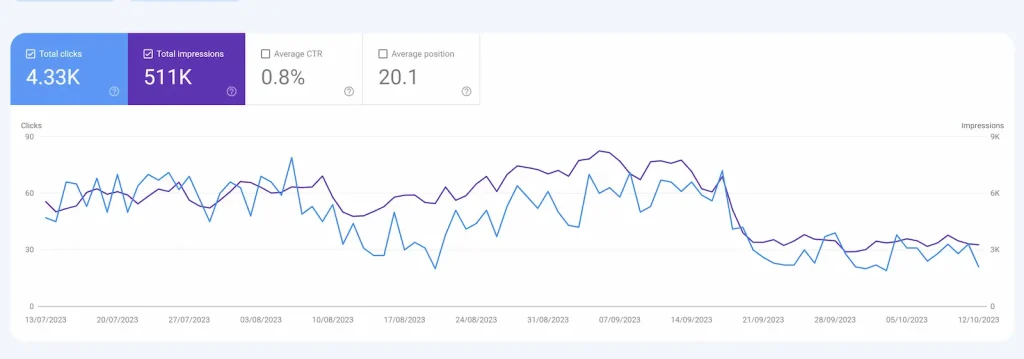Key Takeaways
- XML Sitemap is a document that contains information about the pages on your website
- An XML sitemap has a structured format that can be used to specify the contents of each page or section within the website
- Many SEO experts believe that using XML Sitemaps is one of the best ways to improve your website's SEO
Perhaps you’ve heard about sitemaps, and how important they are to your SEO efforts. But what is the hype about, and, according to Google, do you really need one?
According to Content King:
"An XML Sitemap is a special document that lists all pages on a website and is meant for search engines. Compare it to a telephone book: it tells the search engine what content is available and how to reach it. Furthermore some extra information can be provided, such as when the content was last updated and what the relative importance is of the content."
Wendy Piersall
In short, an XML Sitemap is a document that contains information about the pages on your website. Let’s explain in more detail its functionality – an XML Sitemap file contains information about the contents of a website and its links. It is often used to help search engines better understand a website’s contents and index it more quickly.
In this blog post, we’ll discuss what an XML Sitemap is and how you can use it to improve the visibility of your website. We will also provide tips on how to create a sitemap and how to submit it to Google. These steps are relevant whether you creating a single XML sitemap index or multiple sitemaps. So, if you’re looking to increase the visibility of your website and make it easier for customers to find what they’re looking for, read on!
What’s the Purpose of an XML Sitemap?

An XML sitemap has a structured format that can be used to specify the contents of each page or section within the website. This allows search engines to effectively identify and create a sitemap index of all the pages. Without a sitemap, Google won’t index your website properly.
Sitemaps are also useful for you as a website owner. You can use them to determine which pages are most popular and improve their overall online visibility. By creating an XML sitemap, you can ensure that the site’s content is being properly presented to potential visitors and in turn, increase an online presence.
Finally, you can also use your XML sitemap as a way of communicating your site’s structure and content to third-party developers. This is useful if they are building applications or tools for their websites.
Many of the best SEO strategies for using XML involve incorporating it into your website’s content management system (CMS). This can help you to easily manage and organize your website’s content, making it easier to update and maintain. In addition, incorporating XML into your website’s code can help protect you from potential security breaches.
One popular strategy for using XML is to create rich-content sites with structured data. This allows you to collect valuable information about your users and their interactions with your site. This is valuable to improve the user experience and generate more targeted advertising. Additionally, structured data makes it easier for search engines to index your site, providing greater visibility and attracting more visitors.
What are the Benefits of an XML Sitemap?
An XML sitemap provides several benefits to you as the website owner, as well as the users;
- First, it improves search engine optimization (SEO) by providing a list of specific pages within a website. This can help improve the visibility of your pages in SERPS.
- Next, an XML sitemap can ensure that visitors can find the right information when visiting a website. A list of all the pages on a website can help prevent users from becoming lost or confused while navigating.
- Finally, an XML sitemap can be used as an internal tool for managing and maintaining a number of your websites. It allows you as an owner or SEO manager to easily manage and update individual pages within a site’s structure
All in all, you can expect a massive difference in traffic to your website and the ability to convert visitors into valuable customers in the long run. Submitting your XML sitemap to Google will also help you determine which pages in your sitemap are most important for SEO purposes. Google relies heavily on keyword density when ranking websites. By submitting your sitemap, you can ensure that all the relevant keywords are included in the document.
How to Create an XML Sitemap?
You have several different tools at your disposal to create an XML format site map. Some of the most popular sitemap generators include Google Maps, Microsoft Word, and Adobe Acrobat. It is important to note that not all websites will require an XML sitemap; however, it is a good practice to create one if your website contains significant content pages. This will tell search engines what you are about, and how relevant you are to the searched content.

Step 1: Gather all of your sites’ URLs
This will help you create an XML sitemap that can be used to generate search engine results for your site.
To do this, you will need to input all of the URLs of your website(s). You can either use the URL bar on your browser or input the URL into a text editor like Notepad. Once you have gathered all of your URLs, it’s time to start assembling your XML or HTML sitemap. (Make sure to read our next blog to find out the difference between the two types of sitemaps.)
XML sitemaps are composed of two main parts: the content and the structure. The content part contains all of the individual pages on your website, while the structure part includes information about how those pages are organized.
The most important part of the structure section is the sitemap index file, which is responsible for listing all of your pages in reverse chronological order. This makes it easy for search engines to properly find and index your pages.
Step 2: Code the UrlS
Now that you have gathered all of your URLs and created a content and structure index file, it’s time to create the XML sitemap itself.
To do this, open up a text editor like Notepad and enter the following code: <url> <locale>en_US</locale> <lastmoddate/> </url> ‘’where URL is the URL of one or more of your website pages’’ The locale is either “en_US” or “fr” The last mod date is the date/time that the page was last modified, and default is “now”.
For example, if you have a website with the URL http://www.forexample.com and the locale is “en_US”, your XML sitemap would look like this: <url>http://www.forexample.com</url> <locale>en_US</locale> <lastmoddate/> </url>
Now that your XML sitemap is complete, it’s time to submit a sitemap to Google!
To do this, you will first need to create a file called “Sitemap.xml” in your website’s root directory and add the following code: <urls> <url>http://www.forexample.com</url> </urls>
Next, append the contents of your XML sitemap file as a child document of this “Sitemap.xml” file. Finally, make sure that you set the MIME type for both files to “application/xml” and “application/xhtml+xml”, respectively.
For example, if your website’s root directory is located at www.forexample.com, the final file structure would look like this:www.forexample.com/(Sitemap)www.forexample.com/Sitemap-1x2a7843c-237e-4bae-8f5a-bdd591bb548d_.xml.

How To Submit Your Sitemap For Your Website to Google Console
To submit a sitemap in Google, you need to provide detailed information about your site’s structure, including its HTML code, links, and other metadata. A good way to begin is by taking note of any existing URLs on your website and providing those in your sitemap. It is also a good idea to include any relevant keywords or phrases that you want to be included in the index for your site.
- Sign into Google Search Console and click “Sitemaps” in the left sidebar
To submit an XML sitemap, sign into Google Search Console and click “Sitemaps.” Under “Webmasters,” click “Create a new Sitemap.” You will then be prompted to enter a name and description for your sitemap. Next, you will need to input the URLs of all the webpages that should be included in your sitemap. Finally, you will need to decide whether you want your sitemap to be public or private.
- Add the URL of your sitemap at the top of the page where it says “Add a new sitemap”
To submit your XML sitemap for your website, you need to add the URL of your sitemap at the top of the page where it says “add a new sitemap.” Here’s how to do that:
Click on “Sitemaps & Reports” in the left-hand navigation menu.
Under “Sitemaps,” click on “Create a New Sitemap.”
On the “Sitemap Settings” page, enter the following information:
- Title: “My Sitemap”
- Description: A description of your sitemap
- URL: The URL of your sitemap (e.g., http://mydomain.com/sitemap.xml)
- Inclusion Level: Automatic (default) or Customized for Each Site
Click on “Upload File.” You will then be taken to a page where you can select the file that contains your sitemap XML file.
- Click submit and Google will crawl your newly created XML sitemap
This process can take some time, so be patient. It can take a while for crawlers to, well, crawl a single XML sitemap and look for sitemap errors. Once it’s complete, you’ll be able to see the results on your Google search engine results page.
Next, copy the URL of your Google search results page and paste it into a browser. You will now be able to see all of the pages on your website that were indexed by Google.

Set Up a Sitemap - Help Search Engine Crawlers
Many SEO experts believe that using XML Sitemaps is one of the best ways to improve your website’s SEO. The reason for this is twofold: first, it allows you to document all the important aspects of your website. This includes an image sitemap, video sitemap, titles, metatags, and descriptions. Secondly, it makes your website easier for search engines to find and index.
Though XML Sitemaps is an essential component of any effective SEO strategy, there are some considerations that you need to take into account. First, make sure that you use the correct version of XML Sitemap – there are several different versions available on the internet, and only one will work with Google’s search engine.
Finally, ensure that your XML Sitemaps document is up-to-date – periodically review it to make sure that all the relevant information has been included. And let’s not forget to make sure that you submit your XML sitemap file correctly – failing to do so may result in penalties from Google.
source https://webjuice.ie/xml-sitemap/

Had a bad experience with a flooded drain outside my flat a few weeks back. Tried a few things myself but it just got worse. Ended up calling drain specialists I found through the site, and honestly, they were on it fast. Came out the same day, handled it professionally, and even gave tips to avoid future issues. Really saved me from a bigger mess.
ReplyDelete